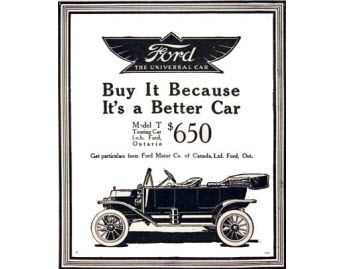Why Small Is the New Big

Small innovations drive our economy. Large-scale inventions – consider the car, for instance – create periodic seismic economic shifts, but it’s the subsequent and persistent flywheel of innovation orbiting these inventions that really builds industries and propels meaningful growth.
Let’s consider the emergence of the car: Henry Ford’s Model T revolutionized American life and helped enable the suburban life enjoyed by roughly 40% of our population. However, it is the more than 100 years of subsequent innovation that serves as the growth catalyst between Ford’s first Model T and the ~$9 trillion worldwide auto sales industry that we have today: innovations like the seat belt and the airbag, which combined reduced road fatalities by 70%; like power steering and brakes, which made cars easier and more fun to drive for the masses; like varied style and design, which propel dozens of luxury brands.
Taken together, these smaller innovations on the basic automotive platform represent the building blocks of a micro-economy. And the innovations simply continue as the next-generation lithium-ion cell batteries, so artfully leveraged by Tesla, stimulate growth in the auto industry, boosting electric car sales 6X over the past five years.
Cable is no different: It all started with the introduction of the television. Ever since the sale of the first commercial TV set in 1928, constant innovation has fueled and shaped our industry.
From the dizzying array of constantly improving features of the TV (like the ultra-thin, 4k-capable displays that drive more than $100 billion in annual worldwide TV sales) to the features that connect to the TV (like the DVR, which sparked the timeshifted viewing that now comprises 16 hours per month for the average U.S. adult), from the stunning, immersive UIs (like the one delivered by our Contour service, which provides millions of U.S. homes with intuitive and intelligent access to an ever growing pool of content and options) to the content ecosystem that flows through the TV and shapes our culture, innovation on the TV has driven nearly every facet of the ~$150 billion video distribution industry that we operate in today.
The introduction of the television was a seismic invention, but the cumulative subsequent innovation flywheel has produced far more economic value for both new and old video ecosystem participants.
There is little doubt that this flywheel will continue to spin, and the annual INTX show is the venue where we all get to peek around the corner at the next innovation wave. This year’s INTX show will be flush with previews of next-generation innovations that introduce new and valuable functionality to our products.
This is precisely why I’ll be there – to collaborate with TV and media innovators, and to experience first-hand the products and services that will shape our collective future and drive cable’s next wave of growth. The beauty of INTX is in its ability to unite the full spectrum of people, ideas, technologies and strategies from across the media and communications landscape to drive new and evolving conversations. It’s the best way to get a view into what’s driving that flywheel. I hope you will join me there.
After all, small is the new big.
Steve Necessary is executive VP of product development and management for Cox Communications.
Multichannel Newsletter
The smarter way to stay on top of the multichannel video marketplace. Sign up below.



